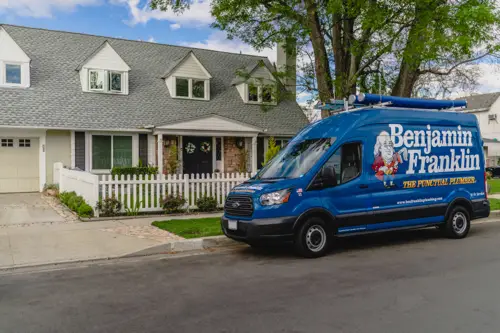 Hey there, Miami, FL, pool owners! Ever notice your that your pool loses water day after day? Don’t panic just yet. Let’s talk about what’s normal, what’s not, and when you might need to call in the pros at Benjamin Franklin plumbing.
Hey there, Miami, FL, pool owners! Ever notice your that your pool loses water day after day? Don’t panic just yet. Let’s talk about what’s normal, what’s not, and when you might need to call in the pros at Benjamin Franklin plumbing.
Why a Pool Loses Water
Here’s the deal: All pools lose some water, especially during those hot summer months. It’s completely normal to lose about 1/4 to 1/2 inch of water each day, mainly due to evaporation. Think about it – when you leave a glass of water outside, it eventually evaporates, right? Your pool works the same way, just on a much bigger scale.
Several factors affect how quickly your pool loses water:
- Sunshine (more sun = more evaporation).
- Wind (even a gentle breeze speeds things up).
- Air temperature and humidity.
- Your pool’s size.
How Much Pool Water Loss Is Normal?
Let’s say you’re losing more than 1/2 inch of water daily – that’s when you might want to start paying closer attention. Here are some situations that might signal a problem:
Overnight Water Loss
If your pool loses water significantly overnight, that’s a red flag. Why? Because evaporation slows way down at night when it’s cooler. If you’re seeing big drops in the water level overnight, you might be dealing with a leak.
Pump-Related Water Loss
- Lost water when the pump is off? Check around your skimmer and main drain – these areas often develop leaks.
- Losing water when the pump is running? Look for wet spots or puddles around your pipes and filter.
Winter Woes
Running a heated pool in the winter months? You’ll probably see more evaporation because of the bigger temperature difference between your warm pool and the cold air. A good pool cover can work wonders here!
Pool Loses Water After Frequent Use
Frequent swimming and splashing also contribute to water loss, along with the back-washing process for the filter. If you’ve had multiple swimmers or recently back-washed, this may be the likely reason for a lower water level.
Common Areas Where Your Pool Might Be Leaking
If you’re suspicious about a leak and how much your pool loses water, here are the usual suspects:
- Skimmer: The skimmer is a frequent source of leaks, especially where the plastic body meets the concrete structure of the pool. Over time, the sealant can wear down, creating small leaks.
- Underground pipes: Underground piping is another common leak source. Shifting soil, tree roots, or aging pipes may lead to cracks or fractures in these pipes, often hidden below ground.
- Main drain: Leaks in the main drain are challenging to address since it’s at the pool’s lowest point. Water loss from this area can lead to faster draining, so monitor this if your water level changes quickly.
- Lights and jets: Worn or damaged seals around lights and jets can also lead to leaks, especially with frequent use. Look for moisture or pooling water near these areas, as it may indicate a leak.
- Pool structure itself: Structural cracks or other weak points in the pool shell can allow water to escape. Check for visible cracks in plaster or tile. Testing with pool dye can reveal the exact point of these leaks, showing where water is seeping out.
How to Check If You Have a Pool Leak
Want to figure out if you’re dealing with normal evaporation or a sneaky pool leak?
Try this simple test:
- Grab a bucket and place it on your pool steps (keep it partially underwater).
- Fill it with water to match your pool’s level.
- Mark both water levels (pool and bucket).
- Wait 24 hours.
- Compare the levels.
If your pool lost more water than the bucket, you’ve probably got a leak on your hands.
Contact the Punctual Plumber for Help
If you’ve done the bucket test and things aren’t looking good, it’s probably time to call in a Benjamin Franklin plumbing professional. Sure, it might cost a bit upfront, but it’s way better than watching your water bill skyrocket or dealing with bigger problems down the road.
Remember, some water loss is totally normal – it’s just part of owning a pool. The key is knowing what’s normal for your pool and catching problems early. Keep an eye on those water levels, and don’t hesitate to get help if something seems off.
And hey, while you’re at it, consider some simple fixes to reduce water loss:
- Use a pool cover (it’s like a lid for your pool!)
- Add some strategic landscaping to block wind
- Create some shade if possible
- Cut back on those fancy water features
Your pool and your wallet will thank you!
 Ever wondered what’s lurking in your tap water? Don’t worry, we’ve got you covered. Let’s dive into the world of water filters and see how
Ever wondered what’s lurking in your tap water? Don’t worry, we’ve got you covered. Let’s dive into the world of water filters and see how  So, you’re thinking about getting a water filtration system for your home? That’s awesome! Clean water is super important, and water filter systems can really make a difference. But here’s the thing – installing one isn’t as easy as it might seem. Let’s chat about why you might want to call in a Benjamin Franklin plumber for installing water filter systems.
So, you’re thinking about getting a water filtration system for your home? That’s awesome! Clean water is super important, and water filter systems can really make a difference. But here’s the thing – installing one isn’t as easy as it might seem. Let’s chat about why you might want to call in a Benjamin Franklin plumber for installing water filter systems. You know that part of your plumbing you never think about? Yep, your sewer lines. They are like the unsung hero of your home, quietly doing their job day in and day out. But here’s the thing – it doesn’t last forever. Depending on what it’s made of and what it’s been through, your sewer line could last for around f0 to 100 years. Pretty impressive, right?
You know that part of your plumbing you never think about? Yep, your sewer lines. They are like the unsung hero of your home, quietly doing their job day in and day out. But here’s the thing – it doesn’t last forever. Depending on what it’s made of and what it’s been through, your sewer line could last for around f0 to 100 years. Pretty impressive, right? Hey there, Miami, FL, homeowner! Let’s talk about something not-so-fun but super important: your sewer line. You know, that unsung hero of your plumbing system that whisks away all the stuff you don’t want to think about? Well, when it decides to take a break (pun intended), things can get messy real quick. So, let’s dive into what happens when your sewer line breaks and how you can spot the trouble before it turns into a nightmare.
Hey there, Miami, FL, homeowner! Let’s talk about something not-so-fun but super important: your sewer line. You know, that unsung hero of your plumbing system that whisks away all the stuff you don’t want to think about? Well, when it decides to take a break (pun intended), things can get messy real quick. So, let’s dive into what happens when your sewer line breaks and how you can spot the trouble before it turns into a nightmare. Choosing the Most Efficient Water Heaters: Benjamin Franklin Plumbing Can Help
Choosing the Most Efficient Water Heaters: Benjamin Franklin Plumbing Can Help When it comes to hot water for washing dishes, doing laundry and taking showers, your
When it comes to hot water for washing dishes, doing laundry and taking showers, your  If you’re installing new plumbing in your home, you may be looking at copper and PEX pipes and wondering which material is the best for your needs. Each option has different qualities that make them worth considering. Copper pipes have been around for centuries.
If you’re installing new plumbing in your home, you may be looking at copper and PEX pipes and wondering which material is the best for your needs. Each option has different qualities that make them worth considering. Copper pipes have been around for centuries. Your plumbing system is one of the most important parts of your home. Having healthy pipes can have a major impact on the overall comfort, energy efficiency, and functionality of the house. Even if you take good care of your piping, it will eventually need to be replaced.
Your plumbing system is one of the most important parts of your home. Having healthy pipes can have a major impact on the overall comfort, energy efficiency, and functionality of the house. Even if you take good care of your piping, it will eventually need to be replaced. The pipes that carry fresh, potable water into your home have a finite lifespan. Although some water supply pipes can last up to 100 years, others can fail after just 20. Factors like excessively hard water, high water pressure, and corrosion can shorten the lifespans of these important plumbing system features.
The pipes that carry fresh, potable water into your home have a finite lifespan. Although some water supply pipes can last up to 100 years, others can fail after just 20. Factors like excessively hard water, high water pressure, and corrosion can shorten the lifespans of these important plumbing system features.